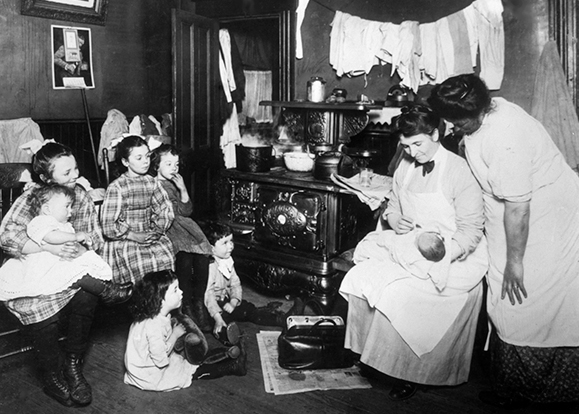A step into the Lower East Side Tenement Museum in Manhattan is a step back in time.
Housed at 97 Orchard Street, one of the first tenement buildings in New York City, the museum is the only one of its kind in the United States. It showcases the ordinary lives of four immigrant families who lived in the building at various times. And the next family to “move into the tenement,” so to speak, will be an Irish immigrant family who lived there in the 19th century.
The museum celebrated its 12th anniversary honoring the Irish immigrant experience and the launch of the museum’s Irish Family Apartment at its annual benefit on June 7 last year. Plans are to open the apartment when the relevant documentation, such as a birth or death certificate, proving that that particular family lived in the tenement, is located, said Steve Long, the museum’s curator. The goal is to have the Irish family “in situ” by 2002.
Though New York was the most Irish city in America in the 1860s and `70s, with almost one quarter of the city’s residents Irish-born, the lives of Irish immigrants are not depicted in any permanent exhibit in a National Historic Site.
The Lower East Side Tenement Museum, which is a private, not for profit, organization, recently received a $15,000 grant from the New York State Council on the Arts. The grant will be used to research the genealogy of eleven Irish families that lived in the tenement at different times. Four main prospects have emerged: Jeremiah Sullivan, Thomas Driene, Charles Dineen and Thomas Feeley. The first three were tracked through Civil War draft records, while the fourth was found through Emigrant Savings Bank documents.
The family that illuminates a historical issue with contemporary ramifications will be the one chosen for the apartment. “A lot of this is detective work for us. We don’t know what we’ll find,” said Long, of the slow, time-consuming process. Research in genealogy, as well as looking into the kinds of things that an Irish immigrant family could have afforded and would likely have put in their home, will start in the spring. And the context of their lives, such as the types of jobs they held, will also be examined. “I should have a much better sense about the family in the summer,” Long adds.
The museum currently features four restored apartments. With the help of guides (many of whom are immigrants), visitors can learn about the lives of the Gumpertzes, a German-Jewish family who lived in the tenement in the 1870’s, the Rogarshevskys, an Eastern European Orthodox Jewish family who lived there in 1918, and the Baldizzis, an Italian Catholic family who lived there during the Depression.
The fourth apartment houses the Confino Program, an interactive, living history event showcasing the life of Victoria Confino, a Sephardic Jewish teenager from Turkey who lived at 97 Orchard Street in 1916.
Between 1863 and 1935, the tenement housed approximately 7,000 people from more than 20 nations in its five story, 20 apartment structure. In 1935, most of the building was boarded-up because the landlord wouldn’t pay for legally required fireproofing of hallways.
After most of the tenants were evicted, the building remained untouched, in a kind of time capsule, for half a century. It was purchased in 1988 for $750,000 to promote “tolerance and historical perspective through the presentation and interpretation of the variety of immigrant and migrant experiences on Manhattan’s Lower East Side, a gateway to America,” according to the museum’s mission statement.
“I hoped to bring longer rooted Americans home to meet their forebears before they were `acceptable,’ before they spoke English, and knew the customs of the country,” said co-founder and museum President Ruth Abram as her reason for establishing the museum.
“My hope has always been (that) by tapping into the reverence Americans have for the pioneers in their own families, that they might extend that appreciation to immigrant families in that same situation today,” she continued. The museum also plans to open an apartment that will interpret an 1893 sweatshop, and to eventually restore two apartments on each floor, bringing a total of eight wonderful slices of history. ♦


Leave a Reply